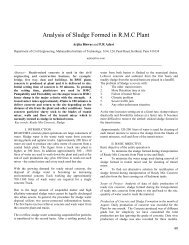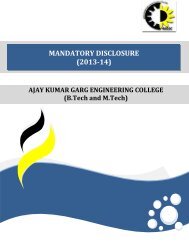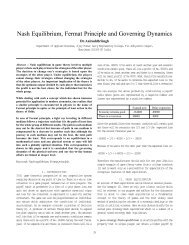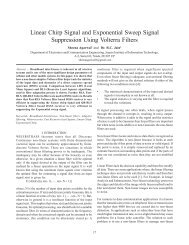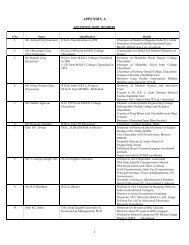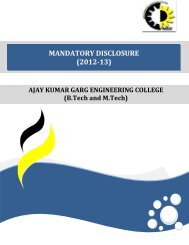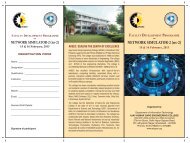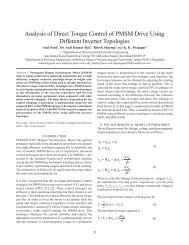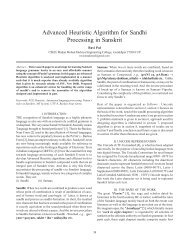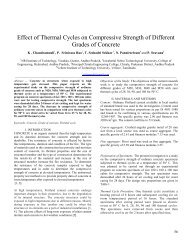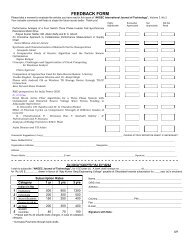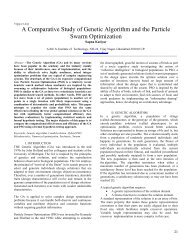Architectural designs and Constructability Issues
Architectural designs and Constructability Issues
Architectural designs and Constructability Issues
You also want an ePaper? Increase the reach of your titles
YUMPU automatically turns print PDFs into web optimized ePapers that Google loves.
AKGEC INTERNATIONAL JOURNAL OF TECHNOLOGY, Vol. 3, No. 1<br />
Figure 10. Rate the following constructability issues with respect to <strong>Architectural</strong> aspects(A-<strong>Architectural</strong> drawings, B-Shape of structure C-<br />
Materials chosen by Architects D-Procedure of architectural <strong>designs</strong> E-Procedure of developing architectural <strong>designs</strong> F-<strong>Architectural</strong> <strong>designs</strong> &<br />
compatibility with site of project G-Compatibility between interior <strong>and</strong> exterior <strong>designs</strong> H-Compatibility between <strong>Architectural</strong> <strong>designs</strong> <strong>and</strong><br />
Climate I-Disregard effects of the l<strong>and</strong> type J-Design dependant on wrong survey information K-Efficacies of low execution knowledge in<br />
Architects L-<strong>Architectural</strong> <strong>designs</strong> & direct affinity to costs & prices M-<strong>Architectural</strong> <strong>designs</strong> & procedure of insulation N-<strong>Architectural</strong><br />
<strong>designs</strong> & acoustic solutions O-<strong>Architectural</strong> new styles & shortage of enough knowledge P-<strong>Architectural</strong> <strong>designs</strong> & Energy saving problems Q-<br />
Lack of 3D drawings for more explanation R-Lack of 3D drawings for more explanation S-Lack of 4D or even 5D drawings for more information).<br />
The factors that has the second highest influence on<br />
constructability issues related to architectural design respect<br />
to figure 10 are compatibility between interior <strong>and</strong> exterior<br />
<strong>designs</strong> <strong>and</strong> <strong>Architectural</strong> new styles & shortage of enough<br />
knowledge(75%), which shows that architects have to make a<br />
plan to show the in <strong>and</strong> out of each concept together also<br />
whenever want to go through the designing new styles first<br />
should finish theoretical information perfectly <strong>and</strong> for each<br />
concept of new <strong>designs</strong> have to draw necessary details.<br />
The third factor that impacts constructability is the procedure<br />
of developing architectural <strong>designs</strong> <strong>and</strong> Acoustic<br />
solutions(65%).<br />
Other factors are also important that engineers should achieve<br />
them <strong>and</strong> focus on them with percent of respondents sequence<br />
<strong>and</strong> find adequate solutions to elimination perfectly.<br />
Not startlingly, the least important factors were marked as<br />
problems depending on surveying issues(10%) or climate<br />
mutability(15%) or l<strong>and</strong> type(20%) which shows that the<br />
procedure of solving these type of problems are acceptable.<br />
VI. CONCLUSION<br />
This paper highlights the need for the study of only<br />
constructability issues not with respect to the architectural<br />
design but also with respect to various other factors which are<br />
a part of the project life cycle.<br />
The literature review <strong>and</strong> the various findings analysed through<br />
questionnaire survey clearly indicate that if projects must<br />
achieve their pre-fixed targets of time, quality, economy, then<br />
construction risks, construction claims, <strong>and</strong> disputes need to<br />
be minimized, if they cannot be eliminated. It is this domain,<br />
which bears a direct co-relation between the constructability<br />
issues <strong>and</strong> the project success/failure aspects.<br />
An integrated approach towards project management, based<br />
on Total Quality Management(TQM) principles may provide<br />
the necessary solution. A micro-level approach incorporating<br />
all the macro variables affecting the project <strong>and</strong> a synergistic<br />
co-ordination, communication during the entire project life cycle<br />
is suggested. Especially, the right/wrong decision made during<br />
project pre-planning will improve/worsen the constructability<br />
issues.<br />
VII. REFERENCES<br />
[1] Design/Construction Integration thru Virtual Construction for<br />
Improved <strong>Constructability</strong> (Paper by Walid Thabet, Virginia<br />
Tech)<br />
[2] <strong>Constructability</strong> Analysis in the Design Firm(Paper by David<br />
Arditi, M.ASCE;Ahmed Elhassan; Y. Cengiz Toklu)<br />
[3] Providing Cost <strong>and</strong> <strong>Constructability</strong> Feedback to Designers<br />
(Paper by Sheryl Staub-French)<br />
[4] Integrating <strong>Constructability</strong> Tools Into <strong>Constructability</strong><br />
Review Process (Paper by Deborah J. Fisher, Stuart D.<br />
Anderson, Suhel P. Rahman, Associate Members, ASCE)<br />
16



